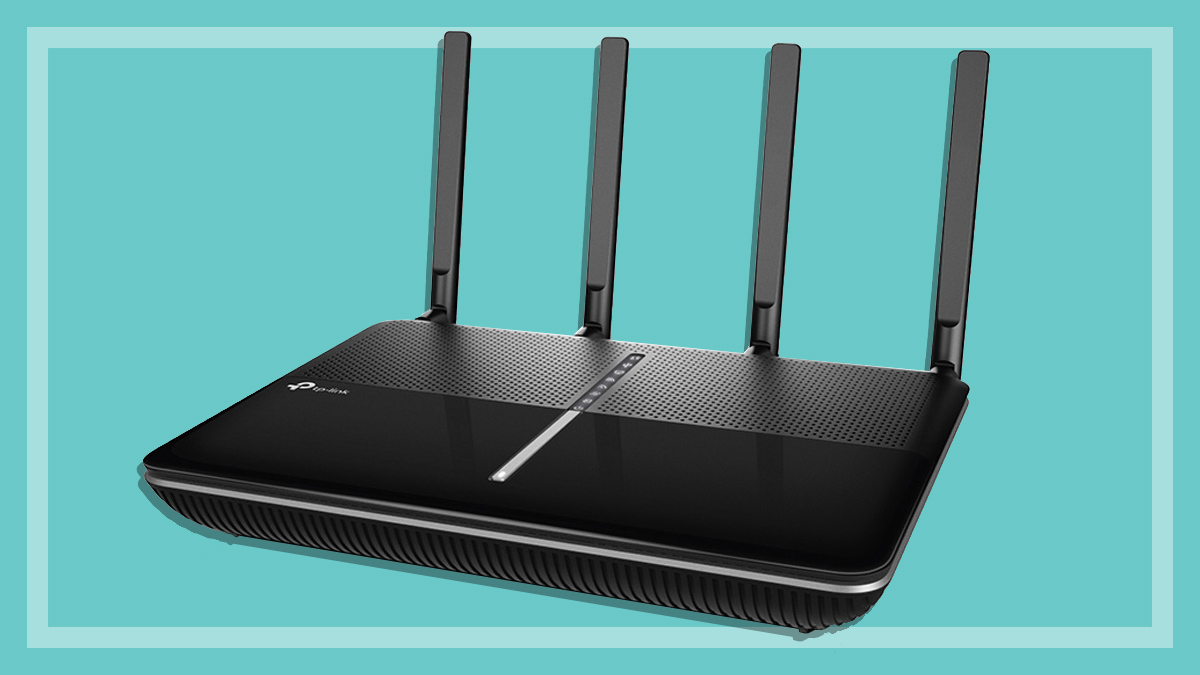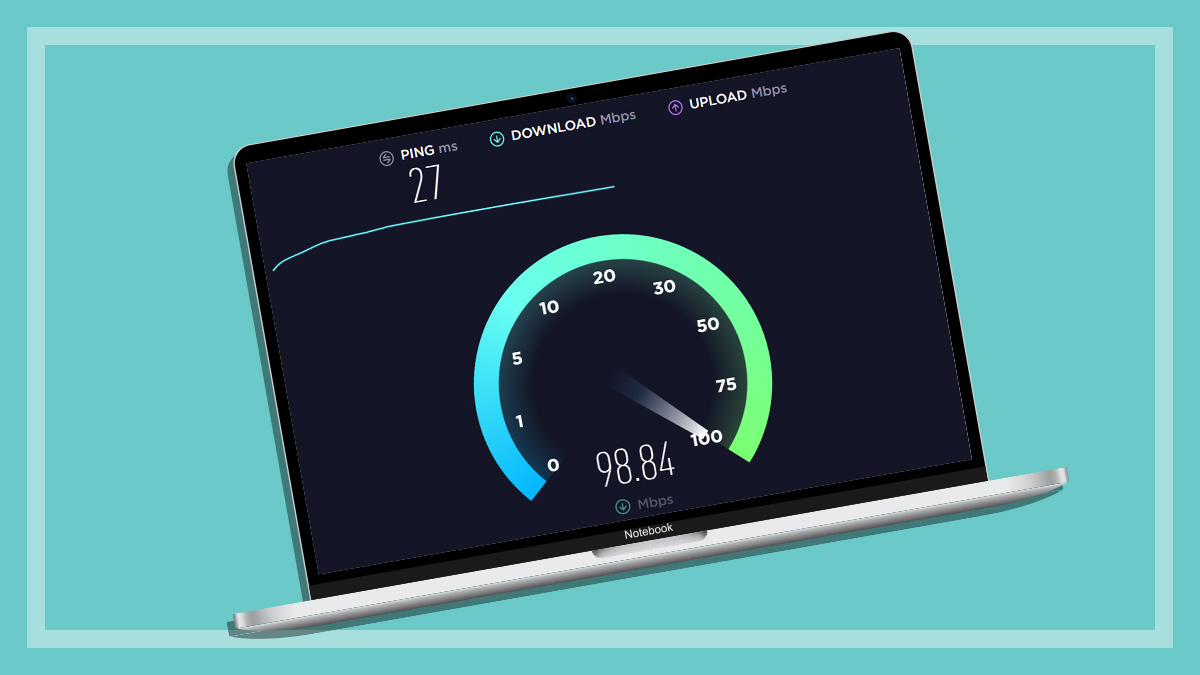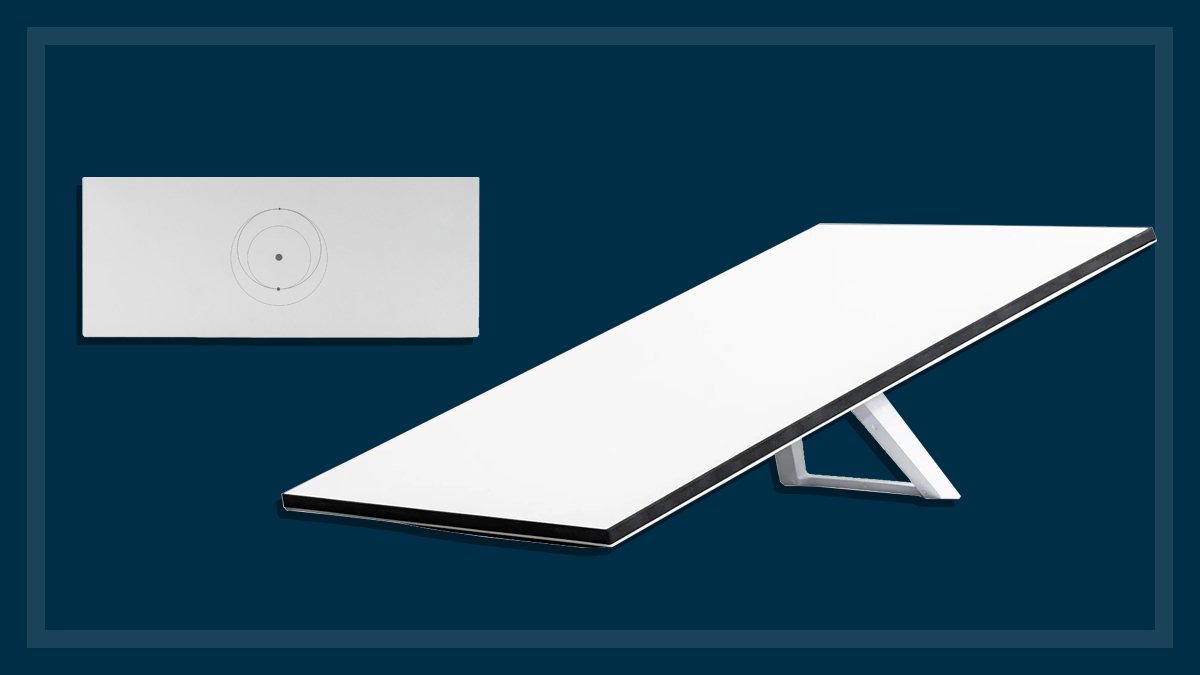Get our independent lab tests, expert reviews and honest advice.
Everything you need to know about the NBN
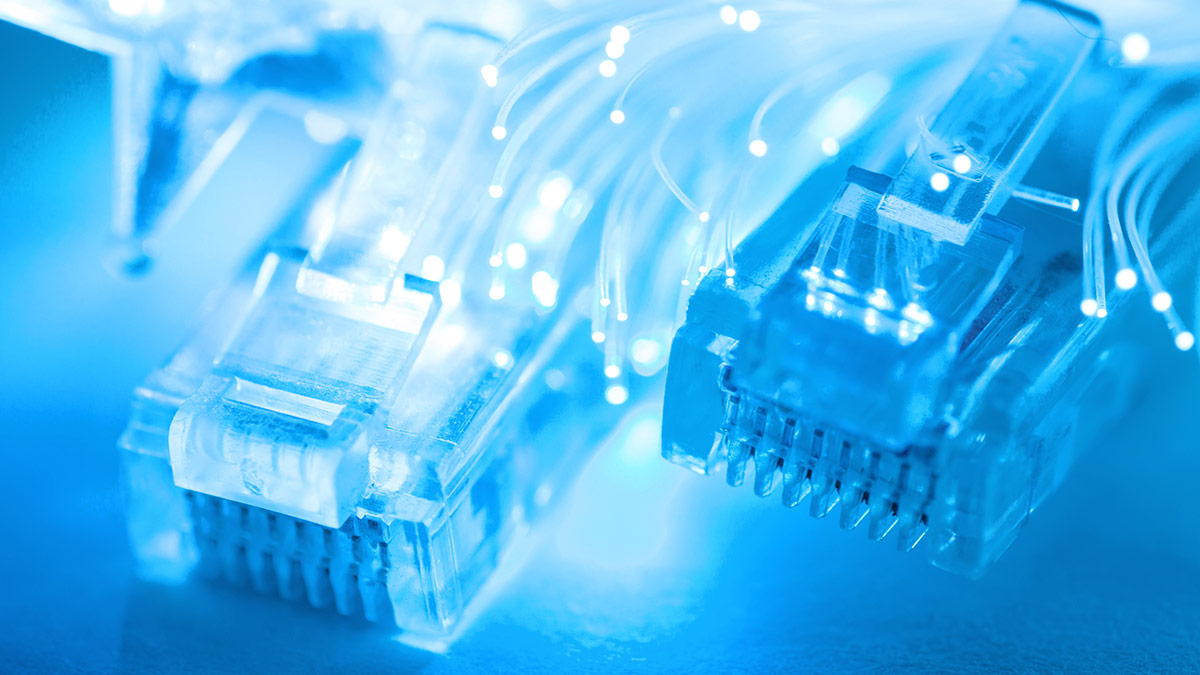
The technical jargon around the NBN can be baffling. We believe you shouldn’t need an engineering degree to read up on it.
On this page:
To help you decode some of the facts about the NBN, we’ve put together this round-up of some key questions about the network, such as the various technologies used in the rollout, what you need to do to prepare, when you’ll get it, how to pick the best NBN plan and who to complain to when things go wrong.
What is the NBN?
The NBN is the new national broadband network, intended to give Australians access to faster internet.
It’s a multitechnology mix (MTM) network, which means a variety of technologies are being used to connect it to premises, including fibre optic cables, copper wire and pay TV networks, as well as fixed wireless and satellite in rural and regional areas.
Connection
The NBN is a multitechnology mix (MTM). The technology your premises is connected to will depend on a few factors, but predominantly it’s what NBN Co decides is cost and time effective in your area.
Because of this MTM approach, not all NBN connections are the same.
POIs are the point where an internet provider, such as Telstra, connects their own network to the NBN. POIs are located in old Telstra exchange buildings.
But while there are thousands of exchange buildings around Australia, only 121 of them contain POIs. This is because more fibre optic cables are doing the heavy lifting for the NBN than it did for previous internet technologies such as ADSL and cable internet.
In saying that, POIs can be much further away from the end user than a Telstra exchange could, while still delivering faster speeds. This is because your speed still heavily relies on what connection technology handles the last little bit of the journey to your house.

Fibre to the node (FTTN)
Fibre to the node (FTTN) is the most common of the so-called copper NBN technologies. Fibre optic cable is run from the point of interconnect (POI) to a node (usually a green box in the street) in your neighbourhood.
From the node, twisted pair copper wiring makes the last leg of the journey to your house – the same kind of cabling used for pre-NBN landline phone services and ADSL (Asymmetric Digital Subscriber Line).
Once there, it uses the pre-existing phone cables in your home’s walls. Inside your home, it looks similar to an ADSL connection – a modem plugs directly into a wall phone outlet.
Although it uses the same cables and wall sockets as ADSL, FTTN employs the far-faster VDSL (Very High-Speed Digital Subscriber Line) technology. FTTN’s use of nodes means less copper than ADSL, which uses copper to connect a premises to a Telstra exchange building.
According to NBN Co, the average distance between an FTTN-connected premises and the node is 450 metres. Two thirds of premises are within 400 metres. The average distance between ADSL connections and the exchange was about two kilometres. While FTTN is definitely hampered by its last-leg copper wires, the amount of copper compared to ADSL is undeniably less.
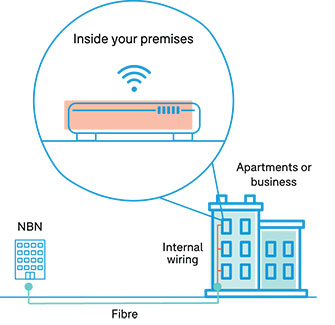
Fibre to the building (FTTB)
Fibre to the building (sometimes called fibre to the basement) is like FTTN, so much so that NBN Co lumps the two together in its corporate plan.
This time, fibre goes all the way from the POI to the communications room of an apartment block or other multidwelling unit (MDU). From there, the building’s pre-existing wiring does the rest.
This usually means less copper wiring is used than with FTTN. However, if your apartment building is old, replacing it with newer wires can be difficult because you may have to negotiate with strata for any rewiring that happens between your apartment and your building’s telco room.
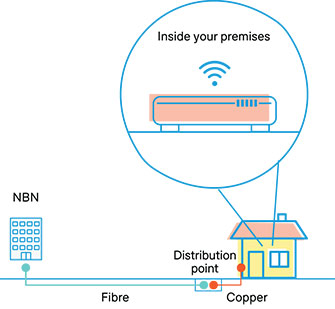
Fibre to the curb (FTTC)
Spelled “curb” (not kerb) because it’s an international standard, FTTC is like FTTN, but instead of a node the copper wiring starts at a telco pit (aka distribution point unit) much closer to your house. Instead of hundreds of metres, the copper cabling is often under 100 metres.
As such, it’s much faster than FTTN. It also has the ability to be upgraded using G.fast technology, which can potentially handle speeds far greater than what NBN plans currently offer.
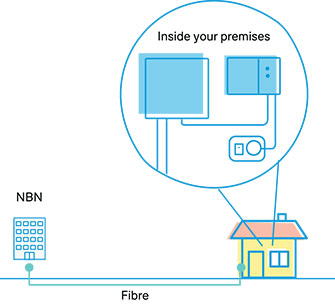
Fibre to the premises (FTTP)
FTTP is the fastest NBN connection technology, taking fibre all the way to your home or business.
A large fibre cable goes from the POI to a (usually beige) fibre node somewhere in your neighbourhood, which splits the signal across smaller fibre cables to finish the journey.
Few older premises are still being connected to FTTP. However, some new developments are getting it.
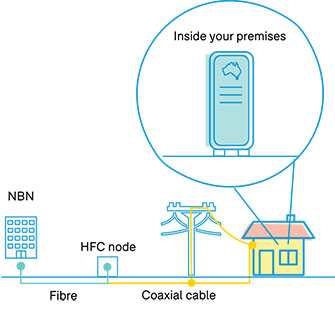
Hybrid fibre coaxial (HFC)
HFC, also known as cable internet, uses fibre optic cable most of the way to your house, after which coaxial cabling finishes the journey.
This differs to FTTB, FTTN and FTTC because coaxial cabling is a shielded copper technology. As such, it can transfer data more quickly and over longer distances without signal degradation.
HFC usually has a much shorter distance between you and where the fibre cabling terminates when compared to FTTN.

Fixed wireless
NBN fixed wireless is used in rural and regional areas where premises are too spread out for fixed-line broadband to meet NBN’s cost requirements.
Fibre optic cable runs to a fixed wireless tower, which transmits a signal via 4G to an antenna on top of your house.
This technology is one of the slowest, and has had many reported speed and congestion problems during peak hours.

Sky Muster satellite
Satellite NBN connections happen via the two Sky Muster satellites, both of which are built and owned by NBN Co.
This connection technology is reserved for the most remote locations, or when sight-lines for fixed wireless signals are blocked by obstacles such as hills or trees.
High-capacity fibre optic cables run to several ground stations which communicate with the satellites. The two satellites are locked in geostationary orbit about 36,000km away from Earth.
That means sending out any signal over the internet and getting a response (such as clicking a link and having a web page load) requires a signal journey of over 144,000km because it has to make the two-way journey into orbit and back twice.
It’s the slowest NBN technology, both in megabits per second and latency. But as far as satellite broadband goes, it’s among the best in the world.
Given the distance a satellite signal has to travel, it’s understandable that it can’t be as fast as a fixed-line technology.
NBN Co has a program called the individual premises switch that enables people to switch the technology that will be connected to their premises.
Individuals or small groups of people can apply to have an FTTN or FTTC connection upgraded to fibre to the premises (FTTP), although it’s subject to certain conditions.
The switch can only be carried out once the original technology has been deployed and is subject to NBN Co’s design and construction plan. It cannot bring forward the construction schedule.
Last time we checked, it was $660 for an application and build quote fee. The build payment (cost of connecting your premises to FTTP) can range from thousands to tens of thousands of dollars.
When the NBN rollout was initially planned, wireless broadband technologies weren’t sufficient to handle the demands of a nationwide internet infrastructure. Speeds were variable and connections were not as reliable as they are today.
Even now, fixed-line internet has many advantages over wireless. Wireless signals can be affected by the weather, and the more devices you connect to a network, the more interference there is in the air. Wireless signals are also blocked by physical obstacles such as buildings, hills and forests.
Fixed-line technologies don’t suffer from these downsides, and tend to be more consistent when it comes to connection speed. Fixed-line is also much cheaper to operate once it’s set up, costing significantly less per byte of information than a wireless network.
5G broadband technology has the potential to shake things up significantly. With its ultra-fast predicted speeds, it could eventually serve as a household replacement for the NBN. But an Australia with nationwide 5G is years away, and it’s yet to be seen if it’s up to the task.
You can check your address on NBN Co’s website for an idea of when you’ll be connected. But keep in mind any information you’re given is subject to change.
Probably. Eventually, almost all non-NBN telecommunications networks will be shut down, leaving an NBN connection as your only option aside from mobile plans.
You aren’t required to sign up to an NBN plan, but you will need to get it installed. But this doesn’t always require any installations on your actual premises if you’re getting FTTN, FTTB or FTTC.
A small percentage of people won’t need an NBN connection installed, though they will still likely need to swap to an NBN plan.
Premises that are deemed “adequately served” by NBN Co don’t need a new connection because what they have is already fast enough. This includes connections such as non-NBN VDSL networks.
If you stay with your current internet service provider (ISP) when you get the NBN and request to keep your home telephone, you should keep the same phone number.
If you’re changing to a different NBN provider, it’s important to:
- let them know you want home telephone in your NBN package
- get the NBN provider to request a transfer of your current home phone number before the transfer to the NBN takes place. If you don’t follow this procedure first, you may lose your old number and be issued with a new one.
Choosing an NBN plan
When choosing a plan, there are a few things to consider aside from price, such as:
- how much data you’ll need
- what speed you’ll need
- customer satisfaction with the provider.
How much data do you actually use on your current internet plan? Your provider will have a way for you to check online.
Keep in mind, you might start using the internet more if your speed increases significantly once you’re hooked up to the NBN.
Don’t sign up to an unlimited plan if you don’t need it. It’s common for people to overestimate how much data they’ll need each month.
You might be able to save money by going with a smaller plan that still comfortably suits your needs. And providers are usually happy to upgrade your plan if you need it. On the other hand, it can be difficult to downgrade if you’re locked into a contract.
As well as choosing the amount of data on your plan, you need to select an NBN speed tier. The more speed you want, the more you pay per month. Check out our best NBN plan article to see what speed you need.
On previous bills, these tiers were named based on their maximum possible speed: 12/1, 25/5, 50/20, and 100/40. For each, the first number represents the maximum number of megabits that can be downloaded per second (Mbps), and the second number represents the maximum megabits uploaded per second.
These days, providers tend to name their speed tiers basic, standard, standard plus, and premium.
Not all NBN connection technologies can handle every speed tier. For example, fixed wireless goes no higher than standard plus, though usually standard or basic is the best you can hope for. Sky Muster goes up to standard, but is often limited to basic-level speeds.
And sometimes it depends on your particular premises, such as if you have FTTN but are located a long distance from the node. In this instance, you won’t be able to get premium speeds.
Basic speed plans are for those who don’t use the internet for much more than email, browsing, and the occasional video. It’s about as fast as the average ADSL2+ connection – the kind of home broadband most Australians have or had before signing up to the NBN.
Standard plus plans are good for heavier users who don’t have too many people in their house. It should be enough to handle multiple high definition (HD) video streams simultaneously, though no more than one 4K video stream at a time. You might even download a large file, such as a video game or operating system (OS) update, without affecting other people in your home.
Premium plans are best suited for families and share houses that use the internet for photo uploads, cloud storage, gaming, and video streaming all at once – especially if you stream 4K video. Premium is the fastest tier most providers offer, but not every premises can achieve these speeds. Your provider should do a line test after you sign up, at which time they’ll tell you if you’ll get value out of a premium plan or if you need to fall back to standard plus.
This depends on your provider and NBN technology. You may find yourself paying upwards of $10 per month more than you did for an ADSL plan with equivalent data.
If you’re on fixed wireless or Sky Muster, it may be significantly more than you paid for ADSL, and you can’t get unlimited data plans.
But if you used to rely on mobile broadband, you may pay a lot less for the NBN.
Because of how the NBN works, smaller, cheaper providers are often as fast as larger ones. Check out our broadband provider performance program for our latest speed test results of the big providers, as well as some smaller ones.
Telstra is required by the government to offer a discounted phone service over the NBN for low-income households. Pensioners on a Centrelink benefit may qualify for the Telephone Allowance to help them pay their phone bills.
Your home phone will need to run via the NBN, but you won’t need to sign up for an internet plan if you don’t want it. You can opt to just have a phone service.
But many providers don’t make this apparent on their website, so you may need to go into a store or call up and enquire.
The new NBN equipment boxes will still be installed in your house by NBN Co or your service provider because the existing copper phone services will be disconnected. Your new phone service will connect via the NBN.
For all fixed-line connection technologies (a connection that relies on fibre optic cables to deliver broadband services to your home), an NBN connection should be good enough for Netflix and other video streaming.
Fixed wireless services (used in rural and regional areas, fibre optic cable runs to a wireless tower, which transmits a signal via 4G to an antenna on top of your house) should be able to stream video during off-peak hours, but it’s common for speeds to drop severely during peak usage times, and heavy rain or storms can also affect the connection.
Sky Muster premises (used in remote locations, fibre optic cables run to several ground stations, which communicate with satellites) should also be able to stream video, but speed is variable and dependent on several factors, such as the weather and network congestion.
Netflix suggests these speeds:
- 0.5 Megabits per second – Required broadband connection speed
- 1.5 Megabits per second – Recommended broadband connection speed
- 3.0 Megabits per second – Recommended for SD quality
- 5.0 Megabits per second – Recommended for HD quality
- 25 Megabits per second – Recommended for Ultra HD quality
Video streaming needs a good rate of download (measured in megabits per second), while online gaming also requires low and consistent latency – also known as ping.
Latency is the amount of time it takes for your device to send out a request and get a reply, kind of like sending someone a letter and timing how long it takes to get one back.
Fixed-line NBN technologies (used in rural and regional areas, fibre optic cable runs to a wireless tower, which transmits a signal via 4G to an antenna on top of your house) should offer consistent latency for most households, though how low it is can differ.
Generally, it’s well within what a gamer might consider acceptable, or at least low enough to avoid frustration.
If this isn’t the case for you, talk to your provider. There may be a problem with the NBN, how much capacity your provider allots you, or with something in your home.
Fixed wireless (used in rural and regional areas, fibre optic cable runs to a wireless tower, which transmits a signal via 4G to an antenna on top of your house) has much higher latency, and as such won’t usually provide seamless online multiplayer gaming.
Sky Muster (used in remote locations, fibre optic cables run to several ground stations, which communicate with satellites) connections can’t support online gaming.
Given the roughly 144,000 kilometre round trip of your signal, latency struggles to get below 600ms – just over half a second. This is impressive for a satellite connection, but far too high for online gaming.
Your equipment
Wondering how the NBN will play with your modem or medical alarm? Or if you’ll need any extra cabling? Here are some answers.
Yes, your old modem/router won’t work. While any hardware needed to connect you to the NBN will be supplied by NBN Co, you need to get a new router or modem/router from your internet provider.
If you do need a new modem but have a separate standalone router you want to keep using, then that router will probably still work.
While you’ll likely be getting a new Wi-Fi router with your NBN plan, you won’t have to replace your Wi-Fi devices.
New Wi-Fi modems work with the 802.11ac standard, but they also support previous ones such as 802.11n and all those that came before it, with the possible exception of the (now ancient) 802.11a.
If you bought your laptop, smartphone or Wi-Fi device within the past 10 years, you shouldn’t have a problem.
Maybe, depending on your premises and the NBN connection technology you get. You’ll need to discuss this with an NBN technician when you’re contacted about your NBN installation.
Upgrading your home’s cables and wires to handle technology often gets overlooked, but you might need to if you want to have the NBN internet services you want, where you want them. For more information on home cabling, check out Home cabling for the NBN.
Medical alarms and emergency call services connected to the copper phone line won’t continue to work after the 18-month NBN transfer window has closed, except in some areas covered by NBN fixed wireless or Sky Muster.
- Register your alarm at nbn.com.au/medicalregister or by calling 1800 227 300 well before the cut-off date.
- Call your emergency or alarm service provider and check if it will work on the NBN.
- Tell your ISP you need priority assistance service levels.
Troubleshooting
This depends on the technology you have. To find out, go to NBN Co’s power blackout page.
Your provider may choose to pass on a $300 new development fee to you, the customer. This is a fee NBN Co is required to levy on providers that place an order for an NBN service to a new development. You cannot dispute this fee with your provider.
If you’re renting a new apartment and you’re charged the new development fee, we recommend you ask your landlord to reimburse you, as it only applies to the first time a new development premises is connected to an NBN plan.
Any new provider plan you sign up to, or any tenant after you, will not incur the fee.
The NBN isn’t replacing all of the internet infrastructure in Australia; it’s only responsible for part of the chain that your data travels along.
Your set-up: Within your home or business, there are several factors that can affect your internet speed such as your router, the quality of your hardware (laptops, phones, etc.), how many devices you have on your home network and the internal wiring of your premises.

The consumer access network (CAN): This is what NBN is replacing with its mixed technology model. The CAN is all the fibre optic and copper cabling between your house and the point of interconnect (POI). The POI is where a telco provider network connects to the NBN. In the case of ADSL, the CAN was all the copper between your house and the Telstra exchange building.
The NBN transit network: The transit network is made up of thick fibre optic cables connecting all the POIs together. NBN is also responsible for this.
Telco provider networks: After the POI, NBN has no control over your data connection. This part of the broadband network is owned and operated by service providers such as Telstra, Optus and TPG. Whenever you do anything on the internet, the signal has to travel through your service provider’s data centre or centres. If this part of the network is congested or faulty, your connection will be affected just the same as if NBN’s network was acting up. Smaller providers who don’t have their own telco network not only have to purchase capacity on the NBN, they also have to pay larger providers for “backhaul” on their networks.
International connections: If you’re visiting a website or using a service that’s hosted overseas, any part of the data journey between your house and another country can affect your connection, including the telco or national broadband networks of that country.
For more tips, see 5 ways to speed up your internet connection.
People often get confused about who to contact when they have a problem with their NBN connection: NBN Co or their internet service provider (ISP).
After all, when you’re getting connected you might have a lot of contact with one or more NBN contractors and assume that relationship would continue after your installation.
In July 2018, the Australian Consumer and Media Authority (ACMA) brought in new rules governing how end user complaints should be handled for people with an NBN plan.
Instead of getting caught in a game of ping-pong between your service provider and NBN Co, you now deal directly with your provider, who will liaise with NBN Co on your behalf if necessary.
Here are some of the complaint rules a provider must abide by:
- Acknowledge a complaint registered via telephone or in-store immediately
- Acknowledge a complaint received by email, post, a recorded telephone message or through its website within two days
- Resolve complaints about alleged billing errors no later than the end of the billing period immediately following the consumer’s current billing period
- Provide confirmation of a proposed resolution of a complaint within 15 working days of receiving the complaint
- Provide confirmation of a proposed resolution of an urgent complaint, and if the consumer accepts the proposed resolution, implement that resolution, within 2 working days of receiving the urgent complaint
- Complete all necessary actions to implement a proposed resolution, within 10 working days of the consumer accepting that resolution, with some exceptions
- A provider must also advise you of any delays to their proposed timeframes, or when it doesn’t believe a complaint can be resolved within 15 working days of receiving it.
Check out the rest of ACMA’s NBN complaint handling standards.
If you believe your provider is not abiding by ACMA’s complaints resolution guidelines, contact the telecommunications industry ombudsman (TIO).
Unfortunately, scammers will sometimes use major government programs like the NBN to trick people into handing over their money or personal details. They pretend to be from NBN Co, a government agency or telecommunications provider to sound legitimate.
NBN Co will never ask for your banking or financial details. If someone rings you or comes to your door saying they’re from NBN Co, we don’t recommend sharing any of your personal details or paying for any equipment.
Ring your own internet provider to get information about NBN plans, so you know you’re dealing with a legitimate service provider.
Contact your financial institution immediately if you think you’ve given your details to a scammer.
When dealing with an NBN technician, that technician or your internet provider should contact you ahead of time to make an appointment. You’ll often be given a phone number and a name. You can check these details with your provider ahead of your appointment.
Why we've partnered with WhistleOut
We've partnered with search engine WhistleOut to help you find and buy the right plan for you. While we make money if you buy through WhistleOut, this doesn't influence our rankings. 100% of the money we make goes straight back into our nonprofit mission.

